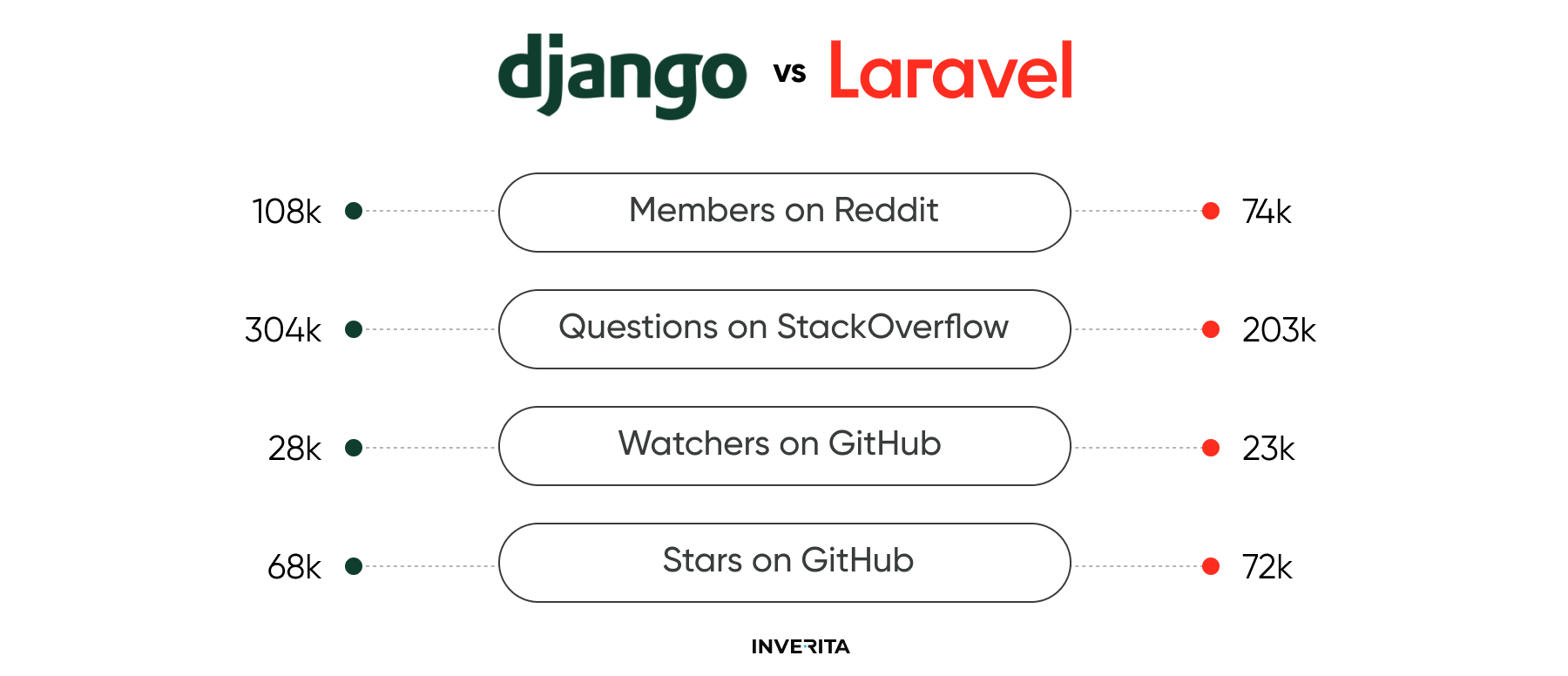Performance Comparison
In Django vs Laravel performance comparison, Django is an absolute winner. In 2018, the frameworks were tested head-to-head for JSON serialization, and Python won with a great difference in terms of speed. Django performed 69k JSON responses per second while Laravel only 8k.
Application Architecture
When selecting a web framework, it's crucial to consider the architectural pattern, as it must align with your project's needs to ensure flexibility and avoid rigid enforcement of architecture and guidelines.
Django Architecture
Django uses MVT architecture which is a variation of popular MVC architecture. In MVT architecture, the template file, which holds HTML and Django Template Language, performs the controller's role of creating dynamic websites. This makes it easier to handle cases like personalizing each user's feed on Instagram.
Laravel Architecture
Laravel, on the other hand, uses MVC architecture that provides full control over the application, allowing for the selection of specific routes and customization of global appearance. This improves the application's SEO. Integrating external APIs and reusing logic is easy with Laravel's MVC architecture, enabling the creation of robust backend support for any web application.
Scalability
The app must scale with the growth of your business and evolving user and market demands. The programming language or the web framework you choose defines the scalability of your application, and its capacity to handle heavy traffic.
Django Scalability
Django is a scalable framework, leveraging the scalability of Python language and its AI/ML capabilities. It integrates with different technologies for optimal performance and fast loading times. It easily optimizes CSS, images, databases, load balancing, etc., and integrates well with cloud and CDN solutions to ensure long-term scalability.
Laravel Scalability
Laravel provides scalability through its use of PHP for supporting growing businesses. When combined with a reliable load balancer and database, it can provide excellent horizontal scaling. You can also scale your Laravel-based applications by taking advantage of AWS, MySQL, and caching. Nevertheless, PHP is not as flexible as Python when it comes to responding to changing demands and new trends. As a result, Laravel's scalability is not as impressive as Django's.
Security
To protect your business and user data, and to save money, you should consider investing in a secure web framework for your application. So, let’s compare Laravel vs Django security.
Django Security
Python is renowned for its security, and Django is no exception. With Django, you can rest assured that your application is well-protected from a variety of threats. It has a secure user authentication system to manage accounts and passwords, as well as measures in place to reduce the chances of common security errors such as XSS, cross-site requests, forgery, clickjacking, etc.
Laravel Security
On the other hand, Laravel, which is based on PHP, has a higher security risk associated with it. To its credit, Laravel uses salted and hashed passwords that do not allow passwords to be saved in the form of plain text in the database, and it utilizes the “Bcrypt Hashing Algorithm” for creating an encrypted password representation. It also has mechanisms to safeguard users from cyberattacks like XSS, SQL injection, intercepting data, harmful cookies, etc. Although the PHP community is working to fix the security issues, in this comparison, Django remains the safer option.
Ease of Testing
Every application sometimes faces performance, security, and user experience issues which can be resolved through regular testing and debugging.
Django Testing
Debugging with Python is not challenging. There are also great debuggers available online to help you test the code, for example, Python Debugger. Therefore, testing a Django-based application is not a daunting task as there are plenty of tools available to make the testing process simpler. To make it more efficient and straightforward, you can refer to their documentation to test the code at different levels to create a robust, bug-free application.
Laravel Testing
Laravel offers two distinct levels of testing: feature tests and unit tests. It also has comprehensive testing documentation to help you test your code at various levels, including mock tests. Sometimes, debugging PHP code can be a challenge, but you can use a PHP debugger like XDebug to make the process easier. With Laravel, you have access to a wide range of testing tools to ensure your application is free of errors so both web frameworks are great in terms of testing and debugging.
Microservices Compatibility
Microservices are used in the development of applications, representing an architectural approach that structures an app as a set of smaller services. These services are designed to be loosely coupled, testable, and easily maintainable, and are organized around the business's capabilities.
Django Microservices
Django is an ideal platform for microservices architecture. It allows for fast deployment, flexibility, and built-in security. By breaking down a Django project into smaller microservices with distinct roles and capabilities, you can scale it quickly. Furthermore, Django is a great option for incorporating ML and AI capabilities into your applications.
Laravel Microservices
Same as PHP, Laravel supports microservices architecture and breaks down the app into small modular components. Each of these components has its own purpose and responsibility, and they communicate with each other through language-agnostic APIs.
For the past few months, the demand for a lightweight version of Laravel that could be used with microservices architecture was so great that a developer created a framework – Lumen. It is a slimmed-down, more compact, and lighter version of Laravel that serves the same purpose.
Community
A thriving developer community can greatly benefit both the language or web framework and its members. Feedback and modifications from the community enhance its functionality, while networking opportunities and expert support allow professionals to collaborate and help each other. Additionally, new developers are welcomed and provided with a space to ask questions and receive guidance from experienced peers.
Django Community
Django benefits from the extensive community of Python. The Django subreddit has a large and active community, with over 108k members discussing the framework and sharing resources. It is also one of the most popular topics on StackOverflow, with more than 304k questions tagged with "Django". The official Django repository on Github has 28k watchers and 68k Github stars, indicating significant interest in the development of the framework.
In fact, the community continues to expand, so we can expect the popularity of Django to grow.
Laravel Community
PHP dominates the server-side programming market for web applications, with a market share of 79%. The Laravel subreddit community has more than 74k members while more than 203k questions on StackOverflow are tagged with “Laravel”. The official Laravel repository on Github has 23k watchers and 72k stars.
The combination of PHP and Laravel forms a robust community, where developers exchange Laravel-related resources, such as podcasts, news, documents, and repositories.










_1764586939-small.webp)

